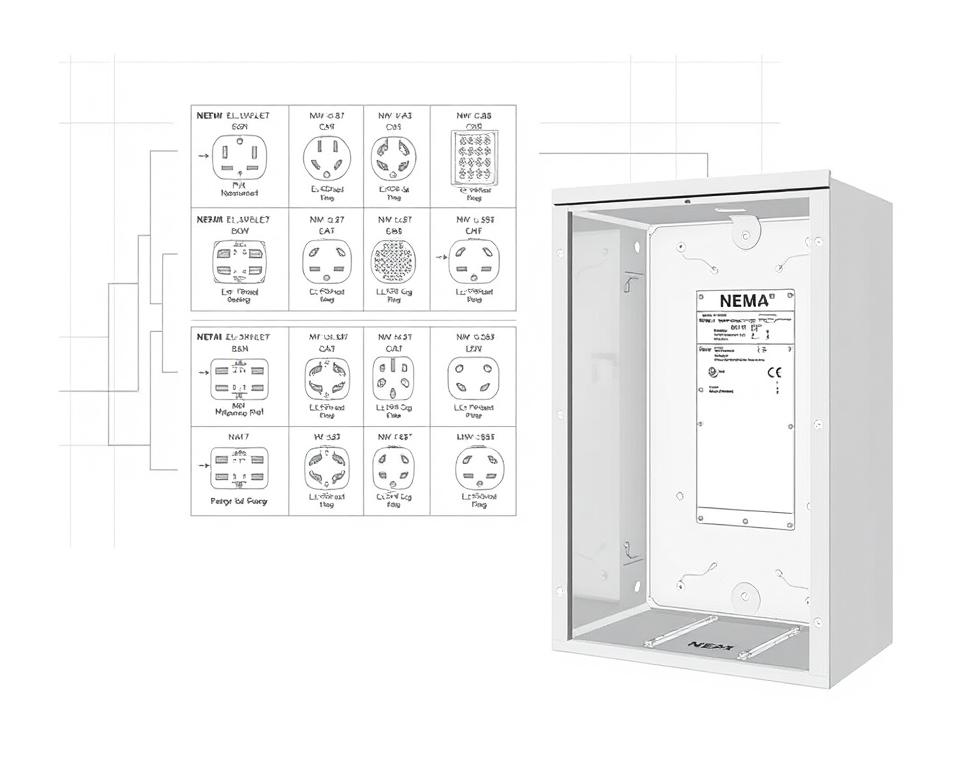NEMA Wiring Diagram Guide for Electrical Experts
About seventy percent of electrical breakdowns across establishments are due to poor wiring techniques. This fact underlines the need of complying with established guidelines, underscoring NEMA wiring schematics’ value for electrical specialists. By means of these drawings, wiring arrangements that satisfy both performance effectiveness and optimal protection standards are presented.
The objective of this guide is to equip electrical practitioners with comprehensive understanding into NEMA criteria. Stressing the importance of accurate electrical arrangements is crucial. By mastering these guidelines, specialists can substantially reduce the likelihood of accidents and ensure they adhere to safety protocols backed by Installation Parts Supply. Knowledge in NEMA l14-30P wiring diagram is essential whether creating new setups or servicing existing ones, as it improves the capacity to provide secure and trustworthy electrical answers.
Main Points
- NEMA wiring diagrams are crucial for guaranteeing electrical security and compliance.
- Adequate wiring methods can minimize electrical failures substantially.
- Comprehending NEMA criteria improves the efficiency of electrical setups.
- Installation Parts Supply encourages following safety standards in electrical operations.
- NEMA schematics cover a variety of uses across different industries.
Comprehending NEMA Standards and Why They Matter
NEMA standards are crucial in the electrical field, steering safety and functionality precisely. Developed by the National Electrical Manufacturers Association, they establish key standards for designing, examining, and marking electrical gear. This ensures uniformity and reliability across all electrical configurations, which is of great value.
What Are NEMA Norms?
NEMA categories differ from levels 1 to 13. Each level specifies the parameters necessary for electrical apparatus to perform optimally. For instance, NEMA 1 offers minimal indoor protection but does not offer dust shielding. On the other hand, NEMA 4 secures devices is watertight, a requirement for withstanding significant water contact. Understanding these classifications is essential in choosing appropriate devices.
Why NEMA Criteria Matter for Electrical Protection
The function of NEMA standards in guaranteeing electrical protection is substantial. They contribute greatly in minimizing electrocution risks, apparatus malfunctions, and burn risks. Correct adherence to NEMA ratings enables equipment to operate safely under particular surrounding conditions. For outdoor deployment, NEMA 3 classifications offer protection against the elements, guarding the device from adverse weather like precipitation and snow. In zones susceptible to explosions, standards including NEMA 7, 8, and 9 are vital for ensuring protection.
Uses of NEMA Standards in Wiring Drawings
The implementation of NEMA criteria in wiring drawings is crucial for safe, optimal electrical setups. These drawings utilize standardized symbols and layouts based on NEMA standards, simplifying the understanding of detailed electrical configurations. This uniformity is helpful. It encourages transparency, uniformity, and reduces misinterpretations, thus improving electrical security across residential and commercial sectors.
NEMA Wiring Diagram Fundamentals
NEMA wiring diagrams are essential for electrical specialists, rendering intricate junctions transparent. They detail the connections and components in different installations. By comprehending the parts, categories, and icons of NEMA diagrams, professionals can improve their performance in installations and servicing.
Constituents of NEMA Wiring Diagrams
NEMA schematics comprise essential parts for particular electrical configurations. You’ll discover wiring terminals, couplers, and various hardware for reliable connections. Each piece guarantees energy is allocated efficiently, in accordance with safety protocols.
Varieties of NEMA Wiring Diagrams
NEMA utilizes various drawings, like linkage blueprints and circuit layouts. Such diagrams detail device interconnections, while arrangements illustrate power flow. Selecting the right schematic aids in diagnostics and installation.
Frequent Symbols Used in NEMA Wiring Schematics
Notations in wiring schematics are crucial for clear conveyance. They represent controls, loops, and couplers. Understanding these icons assists teams comprehend schematics correctly. This ensures setups adhere to NEMA norms.

NEMA Wiring Schematic Features
For electrical experts, comprehending the key components of detailed electrical wiring drawings is crucial. These drawings provide both transparency and wholeness, synchronizing installations with NEMA norms. They necessitate accurate labeling and scaling to curtail setup mistakes. This encourages a more secure and highly efficient workplace.
Primary Attributes of Correct Electrical Wiring Drawings
Accurate electrical wiring schematics are indispensable in electrical projects. They encompass crucial attributes such as:
- Transparency: Drawings should be straightforward, minimizing errors in understanding.
- Completeness: They should incorporate all key elements, linkages, and electrical ratings.
- Standard Compliance: Complying with NEMA criteria is imperative for securing protection and operation.
- Detailed Labeling: Distinct labels on each part are fundamental for understanding and minimizing errors.
- Accurate Proportions: The dimensions should mirror the true setup to represent the configuration correctly.
Comprehending NEMA Coupler Layout
Understanding of NEMA coupler layout is crucial for forming proper linkages in electrical setups. Understanding of specific pin arrangements upholds safety and device operation. There exists a variety of NEMA interfaces, intended for different power levels and amperages, including:
| NEMA Connector Type | Ampere Rating | Voltage Level |
|---|---|---|
| L5-15 | 15A | 125V |
| L5-20 | 20A | 125V |
| L14-20 | 20A | 125/250V |
| L1430C | 30A | 125/250V |
| L620C | 20A | 250V |
| L1430C | 30A | 125/250V |
| L630R | 30A | 250V |
Grasping NEMA connector pinouts is vital for reliable junctions, improving effectiveness. It’s paramount to align couplers with equipment properly using locking or linear blade styles, to dodge safety risks.
NEMA Device Wiring
NEMA appliance wiring includes various configurations for safe electrical appliance connections. These rules confirm that appliances integrate reliably, reducing danger. Knowing the diverse NEMA appliances and their wiring is vital for technicians.
Multiple Types of NEMA Units
NEMA categorizes appliances by category based on voltage levels and amperage needs. Essential arrangements are:
- 2-Pole, 2-Wire
- 2-Pole 3-Wire Grounding
- 3-Pole 3-Wire
- 3-Pole, 4-Wire with Grounding
- 4-Pole, 4-Wire
- 4-Pole, 5-Wire with Grounding
These arrangements are employed in residences and manufacturing plants, handling 125V, 208V, and 480V.
NEMA Outlet Wiring Outlined
NEMA plug wiring changes to suit various energy requirements, with twist-lock types providing reliable interfaces in unstable conditions. For instance, the L5-15 plug works at 15 A, common in enterprise settings, whereas the L14-20 is designed for 20 amperes at 125/250 voltage.
The NEMA naming scheme assists in picking the right plugs, emphasizing attributes like polarity and grounding. Such accuracy secures that devices function safely.
NEMA Receptacle Wiring Instructions
Proper wiring of NEMA outlets aligns with electrical regulations and security protocols. For example, L530R receptacles should be wired for 30 A at 125 voltage, with L630R models for 250 volts. Correct grounding is vital to dodge electrical accidents.
Choosing certified NEMA plugs and receptacles ensures protected, regulation-compliant setups. It’s vital to refer to official standards when installing.
NEMA Motor Wiring and Implementations
NEMA motor wiring is vital in electrical systems, notably for manufacturing use. Knowing how NEMA motor configuration works secures that machines are installed for best efficiency. Such devices, like one-phase and tri-phase models, require proper wiring to function reliably and efficiently.
Introduction of NEMA Motor Wiring
Understanding NEMA motor wiring requires knowledge of linkages and arrangements. Nearly all three-phase motors offer dual-voltage, meaning they can run on both low (208-230V) and high voltage (460V). Wiring at high voltage allows motors to draw less current than at low voltage. High voltage advantages comprise smaller wires for the supply, a notable benefit for engines over 10 HP.
While both NEMA and IEC devices are employed in the sector, NEMA versions are usually bigger and priceier than IEC ones for below 100 HP deployments. NEMA controllers range from size 00 to 9, appropriate for multiple functions. A common characteristic in NEMA trips is a Fault Class of 20, designed to trigger when a motor’s current goes beyond six times the rated current in 10 secs.
Opting for the Correct NEMA Motor Configuration
Selecting the correct NEMA motor setup impacts overall operation and safety. A standard three-wire control circuit utilizes three wires for a start/stop pushbutton panel, facilitating straightforward motor management. Common three-phase arrangements comprise the 12 Lead Dual Voltage and 6 Lead, facilitating Wye and Delta arrangements.
IEC motor starters often include phase failure detection, boosting safety. They also feature adjustable Trip Classes for tailored protection in low voltage operations. Furthermore, many variants have heat protection, critical for one-phase and Dual Voltage configurations.
| Setup Type | Voltage Level | Current Rating | Usual Function |
|---|---|---|---|
| 12 Lead Dual Voltage | Dual Voltage (208-230V / 460V) | Varies by motor size | Applications with Wye Start and Delta Run |
| 6 Lead | One or Dual Voltage | 32 amps maximum | Wye/Delta configurations |
| Single Phase | One Voltage | Varies (1-5 amps adjustment) | Dual Speed and Dual Winding setups |
| Delta Connection | Elevated Voltage | Depending on setup | Current Transformers, multiple configurations |
To Summarize
Understanding NEMA wiring diagrams and standards is essential for electrical experts aiming to enhance their capabilities and comply with electrical security guidelines. These standards secure safe and effective electrical installations but also avert hazards linked to incorrect wiring. As mentioned, adhering to NEMA norms results in the augmented capability of various NEMA units and setups.
For technicians, the choice of quality supplies can greatly affect the result of their projects. Installation Parts Supply presents a vast range of wiring products aligned with NEMA norms. This enables specialists to get vital elements for meeting these key standards. High-quality supplies and comprehensive expertise of NEMA wiring schematics substantially improve system security and efficiency.
During electrical installations, always put security and precision above all. Mastering NEMA criteria offers the insight necessary for implementing industry standards correctly. This secures that each electrical connection established aligns with superior standards.
FAQ
What are NEMA wiring drawings?
NEMA wiring drawings showcase the arrangements and junctions of NEMA-standard electrical devices. They adhere to safety and functional standards established by the National Electrical Manufacturers Association.
How are NEMA standards important for electrical protection?
NEMA criteria are essential to defining safety and functional standards for electrical devices. These principles help electrical specialists minimize electrocution risks, device malfunctions, and fire hazards.
What components are essential in a NEMA wiring diagram?
Key elements in a NEMA wiring diagram comprise circuit configurations and linkage diagrams. These drawings also include comprehensive annotations and depict the electrical system’s different parts precisely for deployments.
Which kinds of NEMA wiring diagrams exist?
Diverse NEMA wiring schematics address various applications, including circuitry for power distribution and connector schematics. Each design serves a unique role in electrical systems.
Identify the common symbols used in NEMA wiring schematics?
Typical symbols in these diagrams symbolize switches, interruptors, receptacles, and more. Use of these symbols encourages effective interaction and correct interpretation of wiring drawings.
Identify the key characteristics of precise electrical wiring diagrams?
Correctness in electrical wiring schematics is defined by their lucidity, comprehensiveness, and explicit annotation. They should conform to NEMA criteria to prevent errors in setup.
Explain a NEMA connector configuration?
A NEMA connector layout describes electrical linkages at a connector, displaying particular pin roles. This secures reliable and effective linkages in electrical systems.
What are the different types of NEMA units?
NEMA devices comprise various electrical outlets and interfaces, like plugs and sockets. They are crafted for different ampere and power requirements to satisfy particular operational demands.
How is NEMA plug wiring set up?
NEMA plug wiring is determined by defined current and power needs, complying with safety standards and regulatory standards for diverse electrical setups.
Identify the recommendations are there for NEMA outlet wiring?
Standards for installing NEMA sockets emphasize following electrical standards, guaranteeing accurate charge alignment, and selecting correct gauge sizes. This maintains both protection and operation in electrical setups.
What is the method to wire a NEMA motor efficiently?
To wire a NEMA motor, one must grasp its specific one-phase or three-phase setup. Opting for the correct wiring method is vital, along with maintaining electrical security for optimized motor performance.
What must be taken into account when opting for a NEMA motor configuration?
Opting for a NEMA motor arrangement necessitates an assessment of the project’s energy requirements and operational characteristics. It’s also crucial to verify compatibility with existing equipment for assured performance and safety.

